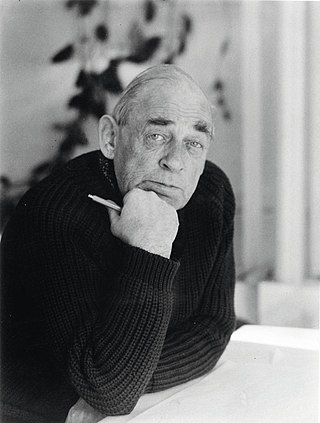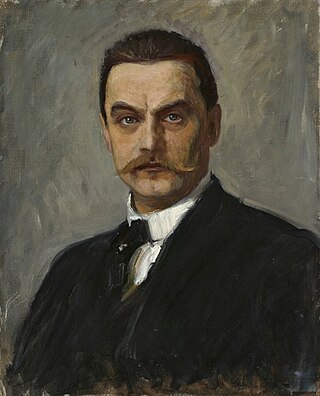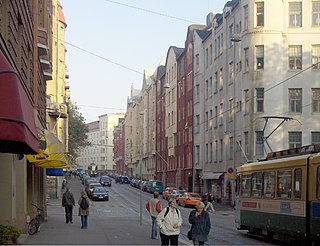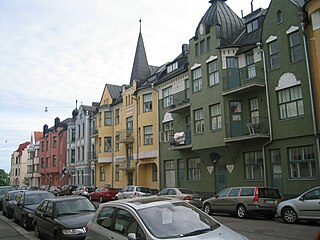
Hugo Alvar Henrik Aalto was a Finnish architect and designer. His work includes architecture, furniture, textiles and glassware, as well as sculptures and paintings. He never regarded himself as an artist, seeing painting and sculpture as "branches of the tree whose trunk is architecture." Aalto's early career ran in parallel with the rapid economic growth and industrialization of Finland during the first half of the 20th century. Many of his clients were industrialists, among them the Ahlström-Gullichsen family, who became his patrons. The span of his career, from the 1920s to the 1970s, is reflected in the styles of his work, ranging from Nordic Classicism of the early work, to a rational International Style Modernism during the 1930s to a more organic modernist style from the 1940s onwards.

Albert Gustaf Aristides Edelfelt was a Finnish painter noted for his naturalistic style and Realist approach to art. He lived in the Grand Duchy of Finland and made Finnish culture visible abroad, before Finland gained full independence. He was considered the greatest Finnish artist of the second half of 19th - the first half of 20th centuries, and one of the most prominent contributors to the Golden Age of Finnish Art.

Herttoniemi is an East Helsinki neighbourhood and a suburb of Helsinki, the Finnish capital.

Kulosaari is an island and an East Helsinki suburb in Helsinki, Finland. It is also the 42nd neighbourhood of the city. Construction of villas on the island started in the beginning of the 20th century, and a bridge from Sörnäinen was opened in 1919. Kulosaari was an independent municipality since 1922 until 1946, when it was merged to Helsinki.

Kaivopuisto, nicknamed Kaivari in Finnish or Brunsan in Swedish, is one of the oldest and best known parks in central Helsinki, Finland, and also a neighbourhood of about 500 inhabitants where the park is located.

Tamminiemi is a villa and house museum located in the Meilahti district of Helsinki, Finland. It was one of the three official residences of the President of Finland, from 1940 to 1982. From 1956, until his death in 1986, it served as the residence of President Urho Kekkonen. Since 1987, it has been the Urho Kekkonen Museum. Tamminiemi is located in a park by the sea. Its floor area is about 450 square metres (4,800 sq ft); living quarters comprise the first two floors while the third floor is dedicated to office space.

Kesäranta is the official residence of the Prime Minister of Finland, located in Helsinki in the neighborhood of Meilahti, overlooking Seurasaarenselkä.

Munkkiniemi is a neighbourhood in Helsinki. Subdivisions within the district are Vanha Munkkiniemi, Kuusisaari, Lehtisaari, Munkkivuori, Niemenmäki and Talinranta.

The Museum of Finnish Architecture is an architectural museum in Helsinki, Finland. Established in 1956, it is the second oldest museum of its kind devoted specifically to architecture. The museum was founded on the basis of the photographic collection of the Finnish Association of Architects (SAFA), which was established in 1949.

Tehtaankatu is an east-to-west street in southern central Helsinki. It leads from the border of Kaivopuisto park near South Harbour to Hietalahti shipyard. Most of the street is in Ullanlinna district, but its westernmost part forms the border between Eira and Punavuori districts.

The Mannerheim Museum is located in Helsinki, Finland. It is dedicated to preserving and displaying items related to the life and times of Marshal C. G. E. Mannerheim, a Finnish statesman and military officer. The Mannerheim Museum is located on top of a hill in a prestigious residential area next to the Kaivopuisto park in Helsinki. The building was the home of Mannerheim from 1924 to 1951. With the exception of a few rooms that have been converted for exhibition purposes, his home has been preserved in its original state.

The Alexander Theatre is a Finnish theatre in Helsinki at Bulevardi 23–27 in the neighborhood of Kamppi.

Ullanlinna is a city district of Helsinki, in Finland. The name Ullanlinna refers to the fortification line that was built at the southern edge of the area during the 18th century, as part of the town fortifications, which also included the fortress of Suomenlinna. The name Ulla refers to the Swedish Queen Ulrika Eleonora (1688–1741). During the 19th century the area was dominated by summer pavilions owned by the wealthy Helsinki middle-classes. The appearance of the area changed gradually at the end of the 19th century as the wooden houses were replaced with much higher stone buildings, designed in the prevailing Jugendstil architectural style synonymous with National Romanticism.

Fabianinkatu 17 is a national romantic-art nouveau building in central Helsinki. Built in 1900–1901 to a design by the architectural firm of Gesellius, Lindgren and Saarinen, it was originally a block of flats, but became increasingly used for offices and was for many years known as the Doctors' House. In 1953 Agronomiliitto, the Finnish Association of Agronomists, bought it, and it is now called Agronomitalo.

Esa Erkki Piironen is a Finnish architect. He studied architecture at Helsinki University of Technology, qualifying as an architect in 1970. He studied architecture and urban design in North Carolina State University in Raleigh, North Carolina, and was awarded the Master of Architecture in 1972. He was working as a teaching assistant at Helsinki University of Technology 1972–81, and was awarded Licentiate in Technology in 1978. Visiting professor at Guangdong University of Technology School of Art and Design starting from 2012.
The Embassy of Sweden in Berlin is Sweden's diplomatic mission in Germany. Ambassador since 2017 is Per Thöresson. Sweden established a legation in Berlin in 1912. During World War II, it was destroyed in aerial bombings and the legation was moved to other addresses in Berlin. After the war, the Swedish legation moved to Cologne in West Germany, and in the mid-1950s to Bonn, where it remained until 1999. During the Cold War, Sweden also had an embassy in East Berlin from the 1970s onwards. In 1999, the new Swedish embassy in Berlin was inaugurated and the one in Bonn was closed. The building complex in which the Swedish embassy is located since 1999 is called Nordic Embassies.

The Sinebrychoff Park, colloquially referred to as the "Koff Park", is a park in Punavuori, Helsinki, Finland, near Hietalahti. The park was named after the Sinebrychoff brewery, which had its premises next to the park from 1819 to 1992 and to whose lands the park used to belong, and the Sinebrychoff family that owned both. In addition to the Old Church Park and Kaivopuisto, the park is among the most popular parks in Helsinki.

Kappeli, also known as Esplanadikappeli, is a restaurant in central Helsinki, Finland at the eastern end of the Esplanadi park, opened in 1867. The restaurant was known as a local favourite among poets, writers and artists during the late 19th and early 20th centuries. In August 2020 the building changed ownership from the city of Helsinki to HOK-Elanto, who currently also owns the restaurant itself.

Sjundby Manor is a manor house in Siuntio in Finland. The history of the manor is known from the year 1417.

Villa Hjelt is a villa located on the Tehtaankatu street opposite Mikael Agricola Church in the Eira district in Helsinki, Finland. The building, completed in 1912, was designed by architect Gustaf Estlander (1876–1930).



















